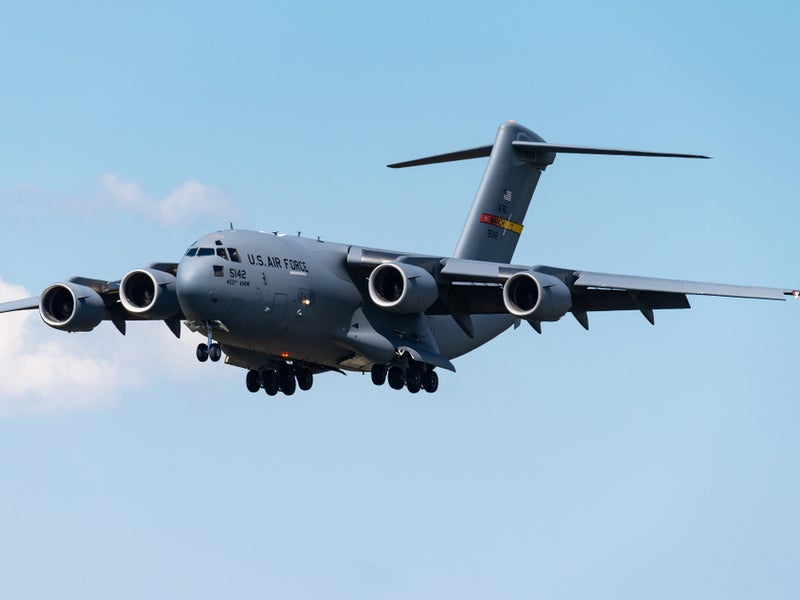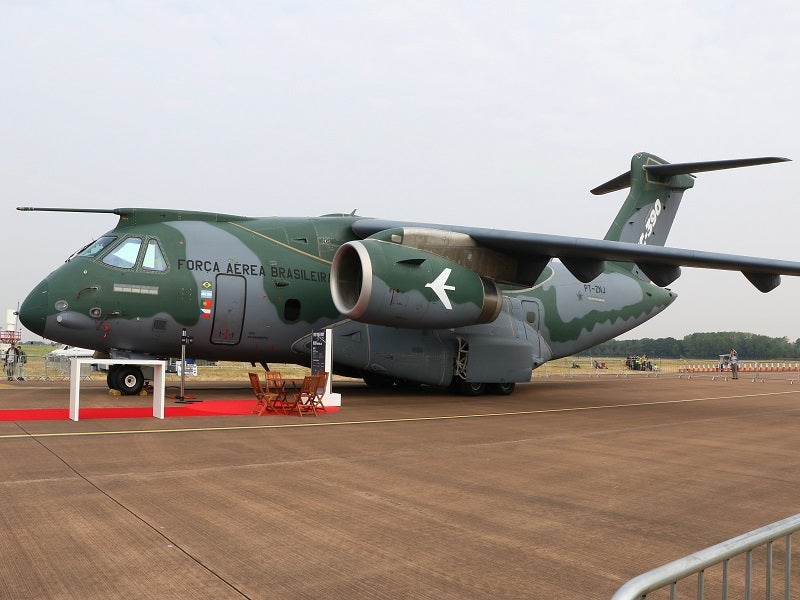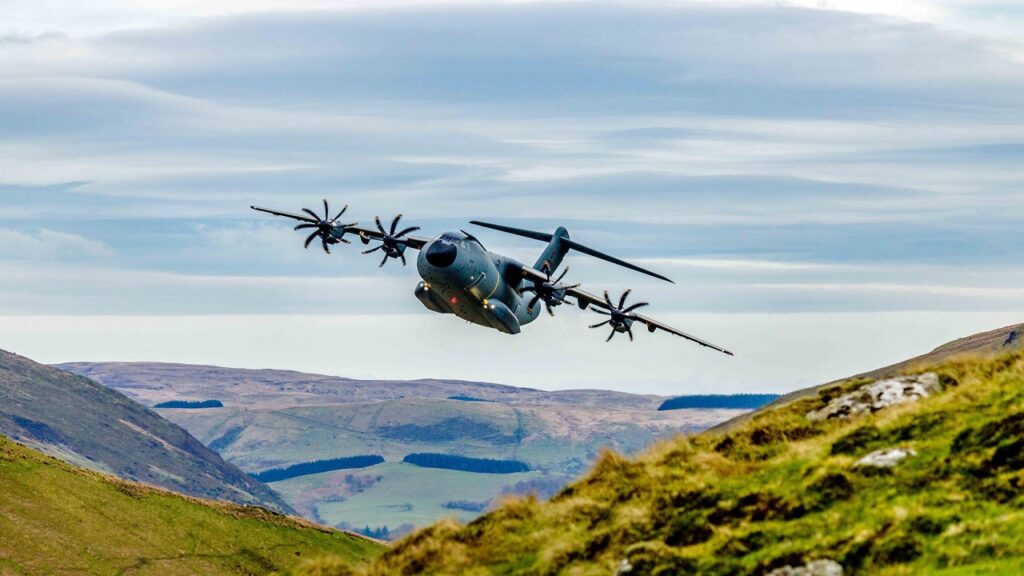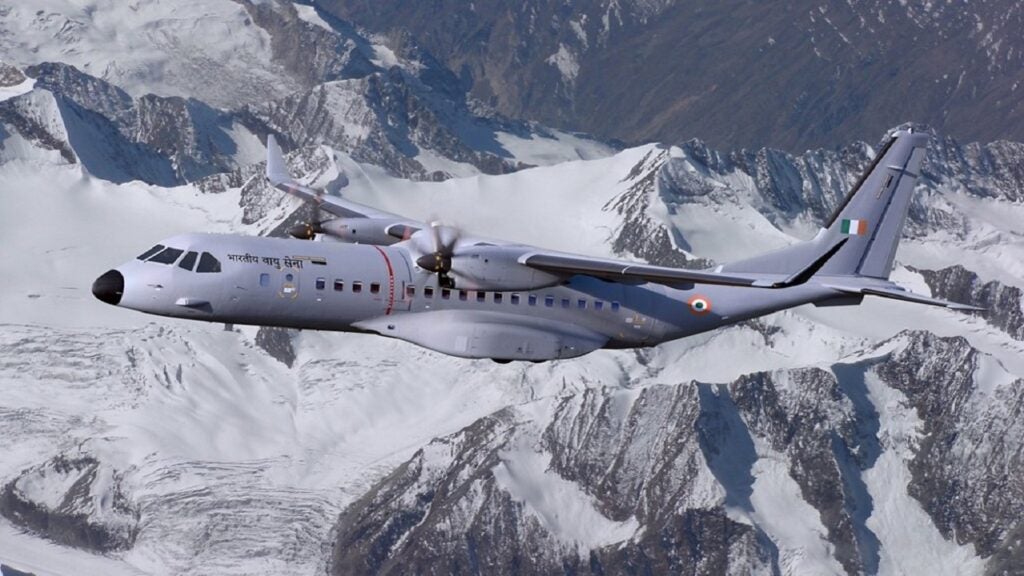
The Boeing C-17 Globemaster III military airlift aircraft is a high-wing, four-engine, T-tailed military transport vehicle capable of carrying payloads up to 169,000lb (76,657kg).
It has an international range and the ability to land on small airfields. A fully integrated electronic cockpit and advanced cargo system allows a crew of three (the pilot, co-pilot and loadmaster) to operate all systems on any type of mission.
In February 2009, a $2.95bn contract was awarded to Boeing to deliver 15 additional C-17s for the US Air Force. Two C-17s were delivered to the Stewart Air National Guard Base in July 2011.
Since it entered service in January 1995, 218 aircraft have been delivered to the US Air Force.
Boeing, in partnership with Mahindra Defence Systems, opened a C-17 training centre in 2016 to serve the Indian Air Force. The company also signed an $8m contract to train C-17 aircrews at its international training centre (ITC) in the UK under the Nato’s Strategic Airlift Capability (SAC) programme. It also trains the Emirati C-17 students.
The final Boeing Globemaster III military airlifter left the company’s production facility in Long Beach, California in November 2015, marking the official end of the aircraft’s production.
C-17 design features
A propulsive lift system allows the C-17 to achieve safe landings on short runways. The C-17 is capable of landing a full payload in less than 3,000ft. The propulsive lift system uses engine exhaust to generate lift.
The engine exhaust is directed onto large flaps, which extend into the exhaust stream, allowing the aircraft to fly a steep approach at a relatively low landing speed.
The C-17 Globemaster III aircraft is capable of turning in a small radius and can complete a 180° star turn in 80ft. It can also carry out routine backing. A fully loaded aircraft is capable of backing up a 2% gradient slope using the directed flow thrust reversers.
Cockpit of the C-17 Globemaster III
C-17’s cockpit accommodates pilot, co-pilot and two observer positions. The digital avionics system has four Honeywell multifunction cathode-ray tube displays, two full-capability HUDs (head-up displays) plus cargo systems.
The quadruple-redundant electronic flight control system also has a mechanically-actuated backup system.
There are two Lockheed Martin central processing computers, one Hamilton Sundstrand data management computer, and two Honeywell air data computers.
A programme to upgrade the C-17A avionics includes new mission computers and displays, new software for the warning and caution system, provided by Northrop Grumman Navigation Systems. The automatic flight control system is upgraded with BAE Systems CsLEOS real-time operating system is certified for GATM (global air traffic management) system requirements.
Cargo systems on Boeing’s C-17 Globemaster III
The design of the cargo compartment allows the C-17 to carry a wide range of vehicles, palleted cargo, paratroops, air-drop loads and aeromedical evacuees.
The cargo compartment has a sufficiently large cross-section to transport large wheeled and tracked vehicles, tanks, helicopters (such as the AH-64 Apache), artillery and weapons such as the Patriot missile system. Three Bradley armoured vehicles comprise one deployment load on the C-17. The US Army M1A1 main battle tank can be carried with other vehicles.
The maximum payload is 170,900lb (77,519kg) with 18 pallet positions, including four on the ramp. Airdrop capabilities include a single load of up to 60,000lb (27,216kg), sequential loads of up to 110,000lb (49,895kg), container delivery system (CDS) airdrop up to 40 containers, 2,350lb (1,066kg) each, up to 102 paratroops.
The transport aircraft is equipped for LAPES (low-altitude parachute extraction system) drops. For Medevac, the C-17 can transport up to 36 litter and 54 ambulatory patients and attendants. C-17s can take off from a 7,600ft airfield, fly 2,400nm and refuel while in flight. It can land on a 3,500ft-long (1,064m) and 90ft-wide (27.4m) airstrip.
Countermeasure technology of C-17 Globemaster III
AN/AAR-47 has a suite of surface-mounted thermal sensors around the aircraft, which detect the thermal signature of the missile exhaust plume. Frequency selection and signal processing techniques are used to minimise the false alarm rate.
The system provides a warning to the crew via the cockpit indicator unit of the presence and direction of the missile threat. A signal is automatically sent to the ALE-47 dispenser.
The AN/ALE-47 is capable of carrying a mix of expendable countermeasures, including jammers. The system interfaces to the C-17 Globemaster III aircraft’s sensors. The aircrew can select the mode of operation of the dispenser for fully automatic, semi-automatic or manual operation.
The cockpit control unit can be used to input mission data, together with the numbers and types of expendable countermeasures systems loaded into the ALE-47. The cockpit controller updates and displays the status of the dispenser and the numbers and types of countermeasures remaining.
ALE-47 is capable of dispensing the new-generation active expendable decoys, POET and GEN-X, in addition to the conventional chaff and flare decoys that are compatible with the previous-generation ALE-40 and ALE-39 dispensers.
A total of 56 USAF C-17 aircraft are equipped with the Northrop Grumman large aircraft infra-red countermeasures (LAIRCM) system.
LAIRCM is based on the AN/AAQ-24(V) Nemesis. It entered low-rate initial production in August 2002 and completed initial operational test and evaluation in July 2004. 25 upgraded aircraft have been delivered. The system entered service in 2007. The four aircraft leased by the UK Royal Air Force (RAF) are fitted with LAIRCM.
Turbofan engines of the transport aircraft
The four Pratt & Whitney PW2040 (military designation-F117-PW-100) turbofan engines with 40,440lb thrust each are integrated in the wings. Engine thrust reversers, which are operable in flight, and speed brakes enable the aircraft to carry out rapid deceleration and descent manoeuvres.
The cruise speed is between Mach 0.74 and 0.77. The range without in-flight refuelling, and with a payload of 160,000lb, is 2,400nm. Aerial refuelling provides an intercontinental non-stop range.
C-17 Globemaster international orders
The C-17 fleet of UK Royal Air Force have flown more than 100,000 flight hours, as of March 2015.
In August 2006, a fifth aircraft (delivered in April 2008) was ordered and the purchase of the first four aircraft in 2008 was confirmed. In December 2007, the UK purchased a sixth aircraft, which was delivered in June 2008. Boeing delivered the seventh aircraft in November 2010. The eighth aircraft was delivered to the UK Royal Air Force in May 2012.
In March 2006, Australia selected the C-17, with a requirement for four aircraft. The first aircraft was delivered in December 2006, the second in May 2007, the third in February 2008 and the final aircraft in March 2008.
Australia signed a foreign military sale (FMS) agreement with the US Government in April 2011 to procure the fifth C-17 for the Royal Australian Air Force (RAAF). It was delivered in September 2011. An order for the sixth C-17 was placed in 2011 and the same was delivered in November 2012. Australia ordered two more aircraft in April 2015 and took delivery of the seventh in July 2015 and the eighth aircraft in November 2015.
In July 2006, Canada announced the selection of the C-17 with a requirement for four aircraft. The contract was signed in February 2007. Deliveries began in August 2007 and concluded in April 2008. An additional C-17, ordered by Canada in 2014, was delivered in March 2015.
In September 2006, Nato announced its intention to buy an initial three or four C-17 aircraft. In June 2007, an international consortium, consisting of 15 Nato countries plus two partner countries (Finland and Sweden), agreed to set up the strategic airlift capability (SAC) at Papa Air Base in Hungary.
The Nato Airlift Management Organisation (Namo) purchases, owns and manages the aircraft. A multinational military unit, the heavy airlift wing (HAW), conducts airlift operations.
In May 2008, SAC requested the foreign military sale of the first two C-17 aircraft. The first C-17 was delivered to the SAC in July 2009. The second and third C-17s were delivered in September 2009 and October 2009 respectively. The SAC1 C-17’s first flight was completed in June 2009.
In March 2007, Boeing announced C-17 production would conclude in 2009, when current orders have been fulfilled. However, the purchase of 15 additional aircraft for the USAF was approved in 2008.
In July 2008, Qatar placed an order for two C-17s with an option for an additional two units. The first aircraft was delivered in August 2009, and the second in September 2009. Qatar received the third and fourth aircraft in 2012. An order for four more aircraft was placed in June 2015.The UAE announced in February 2009 that it would acquire four C-17s. The emirates ordered a total of six C-17s in January 2010. The first C-17 was delivered to the UAE in May 2011 and the second in June 2011. The third C-17 was delivered in July 2011. The last aircraft was delivered in June 2012.
The Indian Ministry of Defence signed a $4.1bn agreement with Boeing in June 2011 to acquire ten C-17 airlifters. US Congress authorised the FMS in May 2010. The C-17 met all the Indian Air Force’s requirements during rigorous field evaluation trials held in India in June 2010. Boeing delivered the first C-17 to the Indian Air Force (IAF) in June 2013 and four more by November 2013. The remaining five were delivered in 2014. The country received the 11th delivery in 2019.
Kuwait received two C-17s in 2014. The sale also included related equipment and training support.
Flight-testing of the C-17 using a blend of synthetic fuel and JP-8 began in October 2007, as part of a USAF process to develop more-efficient fuel for its fleet, with less reliance on imported petrol. Certification for the aircraft powered by synthetic fuel was completed in February 2008.
The company received an $18.7m contract to provide logistics support and training simulator maintenance for the UAE’s C-17 aircraft for two years, in 2017.
Boeing has 700 suppliers in 44 states across the US.
The Global Military Aircraft Market 2011-2021
This project forms part of our recent analysis and forecasts of the global military aircraft market available from our business information platform Strategic Defence Intelligence. For more information click here or contact us: EMEA: +44 20 7936 6783; Americas: +1 415 439 4914; Asia Pacific: +61 2 9947 9709 or via email.
Related content
C-5 Galaxy Transport Aircraft, United States of America
The Lockheed Martin C-5B Galaxy strategic transport aircraft first entered service with the US Air Force in 1986. The USAF has 126 C-5A/B aircraft in service, but is retiring a number of the C-5As.
C-130J Hercules Tactical Transport Aircraft, United States of America
The Lockheed Martin C-130 is the US Air Force principal tactical cargo and personnel transport aircraft.



